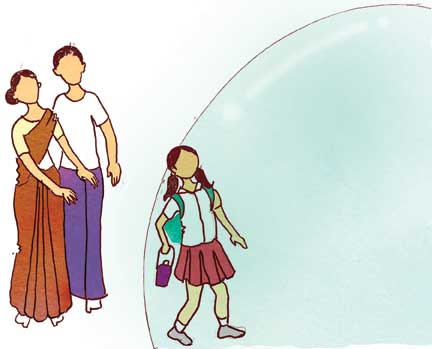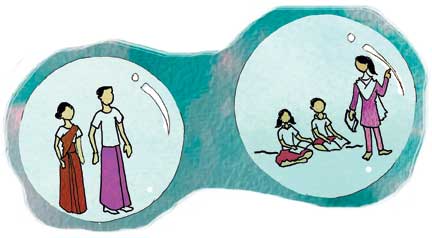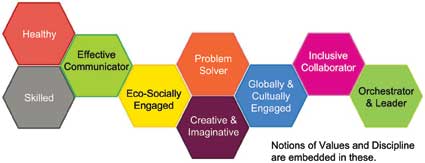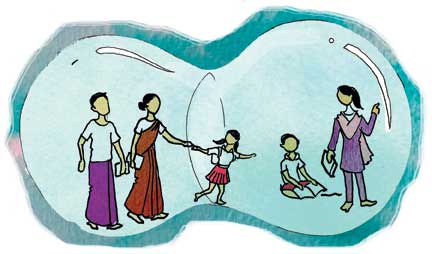Anand Krishnaswamy
What if education was merely a curation of experiences that children have which they reflect on, make sense of and organize? Wouldn’t it, then, be easier to add the experiences of their parents and community into the mix and thereby include everyone in the education of each child?
Most conversations with parents regarding the education of their ward ends with a gentle resignation presented by the parent which often goes like this – “Education today is so complicated that I can’t follow or keep up. After a point, I just ensure that s/he completes the work assigned to them,” – either this or a plaintive cry to the busyness of adult routines. This is true of the urban and semi-urban parent. When it comes to parents of first-generation learners (i.e., students who are the first in their family to go to a proper school to complete a K-12 education), the removal is more stark. These adults are often, at best, educated in their local language up to grade 3 or 5. To be parents of children studying in an English-medium school is at once a matter of pride and alienation. The students, too, very quickly surmise that their parents have nothing much to do with their education, and thus cease including them in any manner whatsoever. Such schools need to acknowledge and find means to include the parents. While the issues are stark and exaggerated in such schools, they are present in nearly all schools (even the most premium of exclusive schools) and addressing these would only add value to the educational experience of the student.

The school where I led the entire academics, was one such school. Located on the periphery of Dehradun (in some way, an education, or at least a boarding school, hub), this school, founded by the grand visionary Mr. G. K. Swamy was focused entirely on children from below poverty-line families. It was the first criterion to be satisfied before a student was even considered for admission. Once assessed for fit, the school took care of all the needs of a developing child. Everything looked perfectly orchestrated when I joined the school (2017) until my first parents-teachers meeting (PTM). I was new, so I flitted around, listening to the kind of comments teachers shared and the concerns of the parents. I was unprepared for the common declaration of many a parent – “Madam, what do we know? We have handed over our child to you. Whatever you say is best for the child, is indeed the best.”
On one side, I was amazed at the amount of trust and faith that the parents placed on the school management and staff – something that implied great responsibility. On the other, I was uneasy with the easy resignation to the apparent wisdom and goodness of an organization. I had to dig deeper. It was then that I truly understood the implications of being parents to first-generation learners. I visited many homes and spoke to parents at length to understand what might go unarticulated in the dynamics of educating their children as a first in the family. To summarize, the non-participation, and hence, alienation that is obviously expected also had an impact on the relationship between student and parent. With each year, the rift was more pronounced and occasionally led to irrational behaviour from the parents (e.g., refusing to let their highly capable ward from pursuing a good line of study because “they would lose control over their child,” etc.).
I decided to take stock of the various points at which parents engage with the school and their child’s education, the nature of each engagement and then visit the question of sufficiency and effectiveness of such an engagement model. On discussion with the school management, students and some parents, the points of engagement were very clear – PTMs, fractious behaviour of ward and (in a manner) the annual day celebrations. When parents were asked if this was sufficient, most felt it was. My hypothesis was that they didn’t know what else might be possible. On the topic of sufficiency of engagement with the child’s education, most felt that it was barely present but had come to assume that that is how all schooling was for everyone. While attempts to improve each of these facets were made over the course of my tenure at the school, I will share two projects and how it helped. Both were in the space of increasing engagement with the child’s education.
Be the teacher
This was conceived and executed as the students’ entry for the Design For Change competition (https://designforchangeindia.com), conducted by the Riverside School, Ahmedabad. When posed with the question, “How might what we learn carry greater value than as preparation for exams?” some of the students suggested that passing it on to others might be a solution. Together we worked on considering the “others” to be their own family and what might the impact of that be. The students were quite excited with the idea of teaching their own parents and grandparents. Over the next few months, they systematically carved out a portion of what they were learning and together worked on how to make it more accessible to their parents. The focus was also on familiarizing their parents with a little English as well. The goals included equipping the parents with the knowledge and confidence to perform minimal numerical calculations so as to transact on domestic purchases (lore had it that these villagers blindly trusted the merchants and paid them whatever was demanded) and at least read road signs and store/retrieve phone numbers on their mobile phones.
We captured videos of this exercise and documented the same. Later, in discussions with the parents, it was gladdening to hear that the parents were highly appreciative of this effort and were able to get a glimpse into what it meant to get educated as well as the utility of education (in their minds, it was often a promised state of betterment, undefined). They were also immensely proud of their wards and their developing ability to teach their own parents.

Localized learning
There was an idea and an effort that started in 2018. In our many discussions and debates, Mr. G. K. Swamy presented his immense disappointment with the boards and curricula in vogue. He felt that they were not aspirational enough. When I had proposed rethinking education to be a development of qualities and values vis a vis subject knowledge, he was intrigued. He encouraged me to flesh it out. Many sleepless nights later, I presented to the school board and management what it would take to develop qualities in students while achieving the requirements of the educational board with ease and greater effectiveness. Unlike a “we stand by these values” stance that most schools take, these qualities were explicitly what we were to develop. Even our timetable would have slots referring to these and not math, English, etc. Some details of this curriculum design can be found at https://a9a9d.medium.com but the final nine qualities are as below.
One of the tenets of this curriculum was the conscious movement from the local to the remote. This implied that every student would definitely know about the soil, fauna, market dynamics, governance, etc., in their village before learning about the same in Dehradun before moving outward to Uttarakhand, India, Asia and the world.

This implicitly mandated connecting deeply with the immediate surroundings and phenomena. Who would know more about it than their own parents and grandparents? This approach pushed the kids to actively gather and seek information from their community and observations and use the classroom and their peers for reflection and organizing knowledge. The teacher, then, would become less of the “expected expert” and more of a facilitator. Parents then could participate more in the educational material of their children. For example, when studying numeracy and language under the theme of “Our Village Administration” (the curriculum basically had themes each month and nearly the entire year’s learning outcomes were repeatedly extracted from each theme), students got to watch how their parents approached and spoke to the village sarpanch (headman) and identified respectful or subservient or coercive speech patterns and vocabulary choices (developing the quality of Effective Communicator).

Going into the details of this curriculum is outside of the scope of this article but it suffices to say that the goal was to ensure that parents and members of the family could pass on their learning and education to their wards, and thus feel more included in their education. We felt that there is immense value in giving currency to their knowledge and experience. They, in turn, got to watch how their children made sense and organized this in the context of developing the aforementioned qualities.
To summarize, it is imperative to find ways to include parents in the education of their wards. This will ensure that there is a collective investment and synergy in this vital effort. Without this we would only continue to perpetrate the notion of education being “outsourced to schools” and of the student being the consumer and schools being the vendors of learning and knowing.
The author is a computer scientist reborn as an educationist. After many years in the research and consultation industry, he quit to teach in under-resourced schools in India, PYDS being the major episode. He can be reached at anand.krishnaswamy@gmail.com.
Related Article
